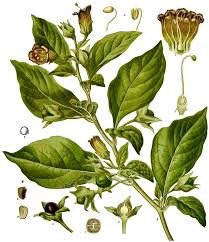Belladonna

This infamous plant is commonly known as ‘deadly’, a name which has been attached to it mainly to ward of children from eating the berries, which are luscious and sweet, but usually result in a painful death for them. The main chemical constituents are scopolamine and hyoscyamine, though the latter metabolizes into atropine upon drying and is the main chemical associated with this plant. These chemicals are known as ‘anticholinergics’ and are capable of inducing delirium, realistic or terrifying hallucinations, a rapid heart rate, difficulty urinating and stupor. However, they are also invaluable for their use in treating nausea, insomnia, toothache, low blood pressure and bradycardia (a dangerously slow heartbeat), and were historically used as sedatives before performing surgery.
Despite the lethal danger to children, Belladonna poisoning does not usually result in death for adults. However, its ability to trap a victim in a waking dream of hallucinations and delirium can have disastrous consequences for somebody who becomes poisoned by her, as they are reliant on others to make sure that they do not confuse their hallucinations for reality and injure or kill themselves in the process. It is for this reason that belladonna is feared for her dangerous power, and will only respond positively to those who employ her aid for reasonable purposes.
One particularly notable instance of its use for poisoning was at the Battle of Denmarkfield near Luncarty in Perthshire during the 11th Century. The Danes, led by Sweyn Knutson, had been pillaging Fife and besieged MacBeth near the River Almond. The Scottish king, Duncan, offered Sweyn and his army wine laced with Belladonna as a sign of truce. By nightfall, the soporific effects of the drug caused the Danes to pass out or become delirious, and were easily massacred by the Scots. Sweyn escaped, but the Danes were expelled from our land for good. There is a standing stone to mark the site of the battle near the village of Luncarty. Archaeological excavations have also unearthed remains of Belladonna seeds at the Medieval town of Elgin in Moray, and they are usually associated with monasteries. After the conversion to Christianity, much of the medicinal lore was kept in the hands of the monks, and healing herbs were a common feature of monastic gardens. Though Belladonna is fairly common in England, it is much rarer in Scotland, as it prefers chalky soil and much of our native soil is very acidic and dense in clay.
Aside from the medicinal uses mentioned above, Belladonna is known to have been used to induce trance and was used in the practice of astral projection, where the user is able to send their hama (‘soul-skin’ or ‘astral body’) into other worlds to attain visions for the sake of divination or healing. It is for this particular quality that the cunning folk sought her aid in private rituals, although they would usually have needed an assistant to watch over them while they journeyed. Typically, Belladonna was used in the form of a ‘flying ointment’ in conjunction with other, more poisonous herbs such as wolfsbane (aconitum napellus) or hemlock (conium maculatum). Atropine is unable to pass through the skin, and so this would reduce the negative effects on the body that would result from ingesting such a chemical. In this context, the entheogenic use would have been more secretive than that of some other substances, though it may have been used by a group of practitioners to achieve spirit flight.
The chemicals in Belladonna are also known to cause lycanthropy, a condition where the subject believes themselves to be a wolf, and may be connected to folklore about werewolves. An elite band of warriors in Norse society was known as the ulfheithnar, and they were supposedly able to invoke the spirit of the wolf to aid them in battle (much like the ‘berserkers’, whom I will mention shortly). It is possible that Belladonna was used in potions or ointments by these warriors for this purpose, and it could also have been used to contact one’s own spirit animal. Belladonna is sacred to Nerthuz and it can be used as part of a Saturday incense.
Posted using Partiko iOS
The name Belladonna actually means: beautiful woman in italian, and gets it's name from another effect: when used as eyedroplets, the alkaloids in this plant have the effect of dilating the pupil (a dilated pupil is considered a signal of attraction, so it was considered desireable at certain times)